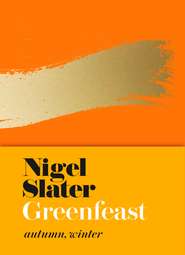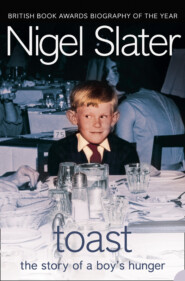По всем вопросам обращайтесь на: info@litportal.ru
(©) 2003-2024.
✖
The Kitchen Diaries II
Настройки чтения
Размер шрифта
Высота строк
Поля
Enough for 8
FEBRUARY 26
A little meal of peace
Sometimes, I rather like noise. The testosterone-fuelled roar of a football match heard from my back garden; the tired and blissfully happy sounds of a crowd singing along at a festival; the swoosh of a barista’s steam wand. But most times I prefer peace and quiet. The sound of snow falling in a forest is more my style – something I have yet to hear this year.
There is quiet food, too. The tastes of peace and quiet, of gentleness and calm. The solitary observance of a bowl of white rice; the peacefulness of a dish of pearl barley; running your fingers through couscous. The thing these have in common is that they are grains or something of that ilk. What is it about these ingredients that makes them so calming? Could it just be that they bring us gastronomically down to earth, show us how pure and simple good eating can be? This is food pretty much stripped of its trappings. It is, after all, the food that many people survive upon.
The peacefulness of grains, their earth tones and the fact that they don’t snap or crunch between the teeth, is what makes them food to eat when we are looking for solace and calm. The fact they are not from a dead animal probably has something to do with it, too.
More and more, I make a main course of what is generally thought of as an accompaniment. Tonight, I make a dish of pale bulgur wheat, cooked with chopped onions, bacon, mushrooms and dill. It is a bit of a hybrid (pork and bulgur are not often found sharing a plate) but it turns out to be one of those ridiculously cheap meals that hits all the right notes.
Bulgur and bacon
I sometimes spoon a little seasoned yogurt – salt, pepper, paprika – over this at the table, stirring it into the grains. But mostly I leave the pilaf as it is, enjoying the warm, homely grains and juicy nuggets of mushroom as they are.
smoked streaky bacon: 200g
onions: 2
olive oil
garlic: 2 cloves
small mushrooms: 250g
bulgur wheat, medium fine: 250g
boiling water from the kettle: 400ml
sprigs of parsley: 3–4
dill: 6 sprigs
butter: 60g
Cut the bacon rashers into short, thick pieces. Peel the onions and slice them thinly. Warm a couple of tablespoons of olive oil in a large, shallow pan over a low heat, add the sliced bacon and stir occasionally till the fat has turned pale gold. Peel and finely chop the garlic. Add the onions and garlic to the pan and leave till soft, golden and translucent, stirring from time to time.
Quarter the mushrooms and add them to the softening onions. Leave them to cook for five minutes or so, with the occasional stir. Add the bulgur with a pinch of salt, then pour in the boiling water. Cover tightly, switch off the heat and leave for fifteen minutes.
Roughly chop the parsley leaves and dill. Lift the lid from the pan and add the butter, herbs and a little salt and pepper. Stir till the grains are glossy with butter, then serve.
Enough for 4
FEBRUARY 27
Coconut cream
One of the reasons I have stayed put for more than a decade is because of the way this house floods with light in the mornings. Softened by closed blinds, the sun that comes in from the east wakes you gently, if a little earlier than you would like. This morning, the rooms fill with honeyed light, like a Hammershoi painting. I suddenly realise how much I have missed it these last few weeks.
Sunlight, even on a relatively cold day, has a habit of changing my appetite. Pasta, potatoes and grains feel inappropriate and heavy. The brown food that has provided such homely comfort on the grey days since the year’s start suddenly looks out of place.
Coconut is one of those ingredients that tend to walk hand in hand with sunshine. It smacks, albeit softly, of trips to Kerala and Thailand, of tiny scented pancakes for breakfast on sun-filled terraces, of lime juice and chillies and, of course, sun-tan oil. All of which is about as far as you can get from a February day within a ball’s throw of Arsenal Stadium.
I met coconut first in the form of a neat, sweet Bounty bar, and as a coating, along with raspberry jam, for the tiny, castle-shaped sponges we wrongly called madeleines. Later, it became the principal seasoning of a holiday in Goa and then, a decade on, of the deep, pale-green soups of Thailand. For an ingredient of which I am not particularly fond, the flesh of the coconut is laden with happy memories.
The finely desiccated coconut that covered my childhood like snowflakes, on everything from jelly mushrooms to fairy cakes and marshmallows, has never set foot in my adult kitchen. It is a flavour I seem to have left behind, like a school blazer that no longer fits. I keep coconut in two forms: as a can of creamy, brilliant-white milk for soups and curries and as coconut cream, a thicker, more concentrated version made from the top of the milk. This latter form is useful when you want the flavour of the nut without introducing too much liquid. Spiked with ground cumin, cardamom and turmeric, it makes a simple marinade for prawns or chicken. It comes in jars and small cans, like the mixers on the drinks trolley of a plane, and is not to be confused with ‘cream of coconut’ whose principal use is in a rum-spiked piña colada.
Coconut cream is the thick, almost paste-like gloop that rises to the top of the pot when coconut milk is produced. You can make your own by adding water to shredded, fresh coconut, bringing it to the boil and letting it cool. On refrigeration, the cream will rise and can be scooped off.
As well as introducing a nutty sweetness, coconut cream works as a balm. I often add the contents of a small can to knock the edge off an exceptionally spicy lamb curry, or indeed to any dish in which I have misjudged the chilli quotient and left everyone breaking out in a sweat.
Chicken wings with coconut cream
You could serve this with plenty of the brick-red, coconut-scented sauce and some steamed rice, but I prefer to reduce the sauce over a high heat, stirring almost continuously to prevent it sticking to the pan, till it is thick enough to coat the chicken wings.
groundnut oil: 2 tablespoons
chicken wings: 16 (or 12 large ones)
fresh ginger: a 60g knob
garlic: 2 large cloves
ground chilli: half a teaspoon
ground turmeric: half a teaspoon
ground coriander: a teaspoon
small ‘new’ potatoes: 250g
chopped tomatoes: a 400g can
coconut cream: up to 320ml
coriander leaves: a small handful
Warm the oil in a deep frying pan. Season the chicken wings with salt and pepper, add to the pan and leave them to colour on both sides. Remove to a plate once they are golden brown.
Peel the ginger and garlic and blitz them to a rough pulp in a food processor. Blend in the ground chilli, turmeric and coriander. Cut the potatoes into thin ‘coins’. Return the empty chicken pan to a moderate heat and add the spice mix from the processor. Once it starts to sizzle and its fragrance rises, add the potatoes and 200ml water. Continue cooking, with the occasional stir, for ten minutes or until the potatoes are approaching tenderness. Stir in the tomatoes, bring to the boil and simmer for five minutes.
Pour in the coconut cream (start with 160ml, then add more as you wish). Season with salt, stir well, return the chicken and any juices on the plate to the pan and leave to simmer for fifteen to twenty minutes, allowing time for the liquid to reduce a little. Turn up the heat and, stirring almost continuously, let the sauce bubble till it has thickened considerably. Scrape away at the bottom of the pan with a wooden spoon as you go to stop the sauce sticking. It should be thick and should easily coat the chicken. Stir in a little chopped coriander, if you wish.
Serve in shallow bowls or deep plates and, being best eaten somewhat messily with the hands, provide something for everyone to wipe their fingers with.
Enough for 4











